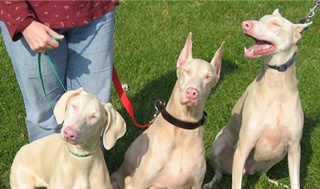Man's best friend shares similar 'albino' gene
16 May 2014
Michigan State University researchers have identified a genetic mutation in Doberman pinschers that causes albinism in the breed, a discovery that has eluded veterinarians and breeders worldwide up until now.
 | |
| Albino Doberman pinschers share a similar gene with humans who also have the condition and display the same characteristics including sensitivity to sunlight. Courtesy photo. |
Paige Winkler, a doctoral student in the College of Veterinary Medicine, co-led the study with Joshua Bartoe, an assistant professor in the Department of Small Animal Clinical Sciences, and discovered a mutated gene that is associated with a form of albinism in humans.
''What we found was a gene mutation that results in a missing protein necessary for cells to be pigmented,'' Winkler said. ''Some defects in this same gene cause a condition called oculocutaneous albinism in humans.''
This type of albinism has certain characteristics that are evident in both humans and dogs.
''With an albino Doberman, you see a white or lighter-coloured coat, pink noses and lips, along with pale irises in the eyes,'' Winkler said. ''These traits are very similar to the characteristics humans display with this particular condition causing light-pigmented skin and hair, along with eye discoloration and vision disturbances.''
The canine breed and people also experience the same skin sensitivity to sunlight, which results in an increased risk of skin tumours.
''We knew that the albino Dobermans typically developed these types of tumours, much like humans, but we wondered what the actual increase in prevalence was between a 'white' dog and a regular-coloured Doberman,'' Bartoe said. ''What we found was a significant increase in risk for development of melanoma-like tumours in the albino dogs.''
Bartoe and Winkler studied 20 dogs of each colour and discovered that more than half of the albino dogs had at least one tumour while only one of the regular-coloured dogs possessed a tumour.
The results of their research could be of great importance to Doberman breeders around the world.
''Because Dobermans can carry the defective gene, but show no signs of the disorder, this has posed serious problems among breeders,'' Bartoe said. ''But now that we've identified the mutation, we can look at the genetic makeup of these dogs and determine if they might be carriers.''
The study can be found in PLOS ONE.






























